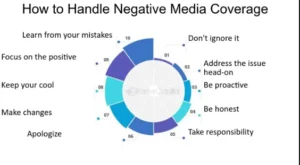Negative Media Coverage for Short : Turning Tides

Negative media coverage can damage a business’s reputation and consumer trust. It can also result in financial losses and decreased market share.
Negative media coverage can have immediate and long-lasting effects on businesses. Negative stories spread quickly, primarily through social media platforms, tarnishing brand image. Businesses must act swiftly to manage such crises and mitigate damage. Addressing the issues transparently and engaging with the audience can help rebuild trust.
Companies can also use positive PR strategies to counteract negative perceptions. Consistent monitoring of media channels and proactive communication are vital in preventing and managing negative coverage. Compelling crisis management plans can help businesses navigate media challenges and maintain a positive reputation.
Contents
- 1 Media’s Cold Shoulder To Short Films
- 2 Roots Of Negativity In Media Coverage
- 3 Impact On Filmmakers And Audiences
- 4 Short Films In The Shadows Of Features
- 5 The Digital Renaissance For Shorts
- 6 Case Studies: Success Against The Odds
- 7 Industry Initiatives To Boost Short Films
- 8 The Future Of Short Films In Media
- 9 Conclusion
Media’s Cold Shoulder To Short Films
Short films often receive little attention from mainstream media. These works of art should be more frequently noticed and appreciated. This lack of coverage affects their visibility and success.
Short Films: The Underdogs Of Cinema
Short films are the underdogs of the cinema world. They face competition from big-budget feature films, and the media tends to focus on blockbuster hits, leaving short films in the shadows.
Despite their creative brilliance, short films struggle to gain recognition. They often feature innovative storytelling and unique perspectives. Yet, they remain largely ignored by the media.
The Neglected Gems
Short films are neglected gems of the film industry. They offer a diverse range of stories and emotional depth, but the media’s neglect means many people miss out on these cinematic treasures.
These films often come from independent filmmakers who pour their heart and soul into their work. They deserve the same attention and respect as feature-length films.
| Aspect | Short Films | Feature Films |
| Media Coverage | Minimal | Extensive |
| Budget | Low | High |
| Storytelling | Innovative | Traditional |
- Short films deserve more media attention.
- They often feature innovative storytelling.
- Independent filmmakers create these neglected gems.
Roots Of Negativity In Media Coverage

Negative media coverage can significantly impact perceptions and reputations. Understanding its roots helps to address the issue effectively. Let’s delve into why negativity often dominates media narratives.
The Bias For Blockbusters
Media outlets have a clear bias for blockbuster stories. Blockbusters generate high ratings and attract more viewers, leading to a focus on sensational news. Positive stories often get sidelined. The media prioritizes stories that evoke strong emotions. Negativity sells faster than positivity. This bias shapes public perception.
Economics Over Artistry
In the media industry, economics often takes precedence over artistry. Media companies aim to maximize profits. They focus on what sells rather than what’s accurate or fair. Sensational and negative news generates more clicks and views. This increases advertising revenue. As a result, artistry and balanced reporting suffer. Media outlets prioritize economic gains over journalistic integrity.
| Factor | Impact on Media Coverage |
| Bias for Blockbusters | Focus on sensational news, sidelining positive stories. |
| Economics over Artistry | Emphasis on profit, leading to sensational and negative news. |
Understanding the roots of negativity in media coverage is crucial. It can help identify ways to promote more balanced and positive news narratives.
Impact On Filmmakers And Audiences
Negative media coverage can greatly affect filmmakers and audiences. It can stifle creativity and skew public perception, ultimately limiting the reach of short films.
Creative Voices Suppressed
Negative reviews and harsh criticism can discourage new filmmakers. Aspiring directors may feel their efforts are not valued, leading to fewer short films being produced.
Established filmmakers may also feel the brunt. They might avoid risky or innovative projects, resulting in a lack of diversity in the stories being told.
| Impact | Description |
| Discouragement | New filmmakers feel undervalued and may stop creating. |
| Safety in Creativity | Established filmmakers avoid risks, leading to less diverse content. |
Public Perception And Accessibility
Negative media coverage can shape public perception. Audiences may only enjoy films with good reviews. This can limit the accessibility of unique and innovative films.
Audiences relying heavily on reviews may miss out on hidden gems. This can result in lower viewership and reduced support for short films.
- Skewed Perception: Audiences may trust negative reviews too much.
- Limited Accessibility: Unique films may not reach a broad audience.
Short Films In The Shadows Of Features
Short films often find themselves in the shadows of feature films. Despite their artistic value and creativity, they struggle to gain widespread recognition. Features dominate the box office and media coverage, overshadowing the potential of short films. This creates a challenging environment for short filmmakers.
Festival Circuit: A Glimmer Of Hope
Film festivals provide a platform for short films and offer a glimmer of hope for filmmakers looking to showcase their work. Festivals like Sundance, Cannes, and Toronto have categories for short films, helping them reach a wider audience and gain critical acclaim.
Benefits of the festival circuit include:
- Exposure to industry professionals.
- Networking opportunities.
- Potential for distribution deals.
Despite these benefits, not all short films make it to the festival circuit. The competition is fierce, and only a select few get the chance to shine.
Limited Commercial Appeal
Short films face limited commercial appeal compared to feature films. The mainstream audience often prefers full-length movies. This preference impacts the revenue potential for short films. Distribution channels for short films are also limited. They rarely get theatrical releases and often rely on online platforms.
Challenges in commercial appeal include:
- Shorter runtime means fewer ticket sales.
- Limited marketing budgets.
- Less interest from major studios.
Despite these challenges, some short films succeed through niche markets and dedicated fan bases.
The Digital Renaissance For Shorts
The world of short films is experiencing a digital renaissance. New platforms and technologies drive this transformation, changing how shorts are created, shared, and consumed. Let’s explore how streaming platforms and social media are leading this change.
Streaming Platforms: A New Dawn
Streaming platforms have opened new doors for short films. These platforms offer a broad reach and easy access, allowing filmmakers to share their work with a global audience.
Here are some benefits of streaming platforms:
- Wider Audience: Shorts can reach viewers worldwide.
- Monetization Opportunities: Creators can earn from their work.
- On-Demand Viewing: Viewers can watch anytime, anywhere.
These platforms create opportunities for new and established filmmakers, resulting in a vibrant and dynamic short-film community.
Social Media As A Game Changer
Social media is a powerful tool for short films. It allows for instant sharing and engagement. Filmmakers can connect with audiences in real time.
Critical advantages of social media include:
- Viral Potential: Shorts can go viral quickly.
- Community Building: Filmmakers can build a loyal fan base.
- Feedback Loop: Instant feedback helps improve content.
Social media platforms like Instagram, TikTok, and YouTube are ideal for short films. They support quick, engaging content that resonates with users.
Case Studies: Success Against The Odds
Negative media coverage can often make or break a short film. Yet, some short films rise above the negativity and achieve great success. This section highlights such case studies of success against the odds.
Cult Classics And Viral Wonders
Some short films become cult classics despite initial negative reviews. These films win audiences over time through unique storytelling and creativity.
- “The Room”: Initially mocked, it became a beloved cult classic.
- “Troll 2”: Labeled the “worst film ever,” now it has a huge fanbase.
Viral wonders often start with a negative buzz but gain traction through social media. Here are some examples:
- “Lights Out”: A short horror film that went viral despite mixed reviews.
- “Kung Fury”: Faced scepticism but became a hit due to its 80s nostalgia.
Award-winning Shorts That Broke The Mould
Despite the odds, some short films break the mould and win prestigious awards. These films redefine genres and capture the audience’s imagination.
| Film Title | Initial Reaction | Awards Won |
| “Paperman” | Mixed reviews | Academy Award for Best Animated Short Film |
| “The Silent Child” | Overlooked at first | Academy Award for Best Live Action Short Film |
These films prove negative media coverage only sometimes dictates a short film’s success. They find their audience and earn acclaim through perseverance and innovation.
Industry Initiatives To Boost Short Films
Short films are an essential part of the film industry. They allow new filmmakers to showcase their talent, and many initiatives support short filmmakers by providing them with resources and opportunities.
Funding And Grants For Short Filmmakers
Many organizations offer funding and grants for short filmmakers. These grants help cover production costs. Here are some popular funding options:
| Organization | Grant Amount | Application Period |
| Sundance Institute | $10,000 – $20,000 | Annually |
| National Endowment for the Arts | Up to $15,000 | Bi-annually |
| Film Independent | $5,000 – $10,000 | Quarterly |
These grants provide essential financial support, enabling filmmakers to complete their projects. Grants also help obtain quality equipment and hire skilled crew members.
Festivals Specializing In Shorts
Film festivals are vital for showcasing short films. They offer a platform for filmmakers to reach a wider audience. Here are some notable short film festivals:
- Sundance Film Festival
- Clermont-Ferrand International Short Film Festival
- Toronto International Film Festival (TIFF)
- London Short Film Festival
These festivals offer various benefits:
- Exposure to industry professionals
- Networking opportunities
- Potential for distribution deals
- Audience feedback
Participating in these festivals can significantly boost a filmmaker’s career. It can lead to new projects and collaborations, and getting featured in a festival can also attract media attention.
The Future Of Short Films In Media
Feature-length productions have long overshadowed short films. But the future is bright for these brief masterpieces. With changing attitudes and better education, the media landscape is evolving. This section delves into how critics and education are shaping the future of short films.
Changing Attitudes Among Critics And Journalists
Critics and journalists are beginning to recognize the value of short films. The internet has given these films a larger audience. Many critics now see short films as a unique art form. They appreciate the creativity and innovation that short films often display.
Journalists are also covering short films more extensively, writing articles and reviews that highlight their importance. This change in attitude is critical for the future of short films, allowing them to gain the respect they deserve.
The Role Of Education In Appreciating Short Films
Education plays a significant role in helping people understand short films. Schools and universities now include short films in their curricula, which helps students see their artistic value.
| Institution | Course | Focus Area |
| Film Schools | Film Studies | Short Film Production |
| Universities | Media Studies | Short Film Analysis |
| High Schools | Art Classes | Creative Filmmaking |
Workshops and seminars also help in educating the public about short films. These events often feature screenings and discussions. They provide a platform for filmmakers to share their work and insights. This education fosters a deeper appreciation for short films.
- Film Festivals often feature short films.
- Online platforms provide access to short films.
- Social media helps promote short films.
With these changes, the future of short films looks promising. They are becoming more integrated into mainstream media, and as attitudes shift and education improves, short films will continue to thrive.
Conclusion
Negative media coverage can significantly impact individuals and businesses. It’s essential to manage and respond effectively. Proactive measures can mitigate damage and rebuild trust. Stay transparent and engage positively with your audience. Effective communication can turn negative situations into opportunities for growth and improvement.

